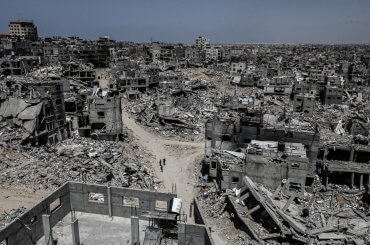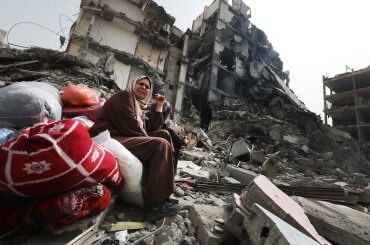In his 1984 essay Permission to Narrate, the renowned Palestinian writer Edward Said explained that Palestinians were denied permission to narrate their existence and their experiences of dispossession and discrimination by the Zionist movement and Israel. Said explained:
A disciplinary communication apparatus exists in the West both for overlooking most of the basic things that might present Israel in a bad light and for punishing those who try to tell the truth. How many people know the kind of thing suggested by the following incident-namely, the maintenance in Israel of a rigid distinction between privileged Jew and underprivileged Palestinian?
Sadly, more than 30 years later, US media outlets, including the powerful New York Times, remain a part of the “apparatus” that refuses to report basic elements of Palestinians’ experiences, including the perspectives of Palestinians living in Israel. Reporter Diaa Hadid’s January 3 article in The New York Times on Palestinian citizens of Israel living in Haifa provides a recent case in point.
Rarely a focus of international media, Palestinians make up 20 percent of Israel’s citizens. Hadid’s article emphasizes Palestinian life in Haifa as more “liberal” than in other Palestinian towns and communities within Israel – with bars, arts, dating, unmarried co-habitation and a gay community. However, the article does not include any discussion of Palestinians’ status in Haifa and in Israel, as a minority community that suffers under a discriminatory government.
Immediately after publication, one Palestinian interviewee for the article, Ayed Fadel responded to the article on Facebook complaining that, “there are so many points missing, crucial ones, that the lack of them make this article shallow, offensive and degrading.” Mr. Fadel said that he spoke primarily about cultural resistance in his interview, but that was not reflected in the article. His complaints were quickly picked up on social media and on Mondoweiss. A Palestinian poet from Haifa, Asma’a Azaizeh also published an article in Arabic criticizing Hadid’s story in the Lebanese paper Assafir.
New York Times’ Public Editor Margaret Sullivan then took up the issue in a January 8 blog post critical of the article. She wrote that, “The Times can do better with providing more context and information, even in a feature story,” and “this article needed more political and historical information to put it in perspective.” With regards to specific complaints from Ayed Fadel and other interviewees, Ms. Sullivan wrote: “the writer can try to make sure that the main points – the overall thrust of the conversation – is represented … that didn’t seem to happen here.” Ms. Sullivan then posted a second blog post on the article in which Diaa Hadid accepted some of the criticism while defending herself against other complaints.
But simultaneous to this resistance and assertion of Palestinian experience that burst forth via the internet and penetrated one part of The Times, another part of The Times seems to have pushed back to silence Palestinian identity. Ms. Hadid’s article referred frequently to Arabs in Israel as “Palestinian,” and said they “have grown more assertive in expressing their Palestinian identity, allied with their brethren in East Jerusalem, the West Bank and the Gaza Strip.” At publication, the article’s headline noted the article was about “Palestinian culture.” Yet at some point after publication, for no reason that was explained or documented, The Times deleted the word “Palestinian” from the article’s headline, replacing it with “Arab Culture.”

The current online headline for the article is now: In Israeli City of Haifa, a Liberal Arab Culture Blossoms. However, the online article notes at the very bottom: A version of this article appears in print on January 4, 2016, on page A4 of the New York edition with the headline: A Liberal Palestinian Culture Blossoms in an Israeli City.
When they bother to report on them, The New York Times and many other US media outlets have historically preferred using the term “Israeli Arab” to describe Israel’s Palestinian citizens. One element of a colonial-style divide and rule policy, “Israeli Arab” is used by the Israeli government and a majority of Israeli Jews. UCLA Professor Saree Makdisi recently derided the LA Times for using “the generic term ‘Arabs’ or ‘Israeli Arabs’ to refer to the Palestinians who live inside Israel, falsely distinguishing them from the Palestinians who live in the territories occupied by Israel in 1967 or those who were driven into exile during the destruction of Palestine in 1948.” Makdisi explained, “The fact that the Palestinians inside Israel are an integral part of the Palestinian people is absolutely central to the history of this conflict as well as key to its resolution.”
The Times’ headline change was made quietly, and contrary to the wishes of its reporter Diaa Hadid, who had defended the initial use of the word Palestinian in the headline in a tweet, and later told Public Editor Margaret Sullivan “that she had been unaware of the headline change … and that she would have objected to it.” Typically editors, not reporters, write story headlines.
Even recent New York Times Jerusalem Bureau Chief and now deputy international editor Jodi Rudoren acknowledged in a 2012 article that, “After decades of calling themselves Israeli Arabs, which in Hebrew sounds like Arabs who belong to Israel, most now prefer Palestinian citizens of Israel.” Polling data supports Rudoren’s position.
Following on an email I sent raising questions about the headline change, Margaret Sullivan commented on the issue in her first blog post on the article:
Although headlines often change (and, in my view, such changes do not normally require an editors’ note or other explanation), Mr. Connors is probably right that this one involved something other than simple word count or search optimization. (I asked Mr. Slackman [the international managing editor] about the change; he said he was unaware of it but would look into why it was made.)
After her second blog post offered no more information on Michael Slackman’s promised investigations, Ms. Sullivan responded to my renewed inquiry saying, “Having written two posts last week about the Haifa story, I have no immediate plans to do anything more, although how and why headlines change between editions does interest me and I may return to it.” Michael Slackman did not respond at all to my subsequent request for further information.
I can only speculate why The Times’ surreptitiously changed the headline to insert terminology preferred by the Israeli government, did so in a manner that aroused the interest of the Public Editor, but now won’t say anything more about it. Clearly The Times continues to restrict what Palestinians – in this instance Palestinian citizens of Israel – are permitted to narrate in its pages. In Ms. Hadid’s article Palestinians were permitted to comment on culture, but not on their cultural resistance to the larger context of discrimination by Israel’s ruling Jewish majority. My quick search of other New York Times articles suggests that, while Palestinian citizens of Israel are now sometimes allowed to express their identity as Palestinian within the body of Times articles, that identity is banned from Times headlines.
Though Palestinians’ self-identification as Palestinians is recognized by Times staff as fact, The Times still will not grant permission for that proven element of the Palestinian narrative to make its way into the headlines. Saree Madisi’s excoriation of the LA Times over their continued use of the word “Arab” then applies equally well to The New York Times. Professor Makdisi asserted that its unacceptable “to look the other way, or pretend not to hear, when a people insists that they are a people and that they have a right to freedom and a will to be free.”
The New York Times should move forthrightly in the month ahead to address the disconnect between the language on-the-ground journalists are finally beginning to incorporate regarding “Palestinian citizens of Israel” and the antiquated, colonial language referencing “Israeli Arabs” still employed by editors in New York.



From 1948 until Oslo it was a norm of Israeli discourse to recognize only “Arabs”. The word “Palestinian” was prohibited. No such species existed. That applied not only to “Israeli Arabs” but to all the other categories of Palestinians. For instance, the people in the refugee camps were “Arab refugees” not “Palestinian refugees.” The purpose of this norm was to minimize Israel’s guilt for the Nakba and any right the exiles might have to return. The expelled “Arabs” had not been robbed of their homeland but merely transferred from one province of the broad Arab homeland to neighboring provinces — not such a big deal. Viewing the Palestinians simply as “Arabs” makes possible the still popular argument that “the Arabs have so many states, why can’t we be allowed just one?” (During its heyday pan-Arab nationalism inadvertently facilitated this Israeli usage.)
With Oslo the existence of “Palestinians” received official recognition, but it was not explained who they were, where they had come from, or why they had suddenly moved out of non-existence and into existence. It was not admitted that the earlier usage had been erroneous. Ordinary Israelis and Zionists still felt uncomfortable with the word, and not only because it was rather long.
The people now in power in Israel seek to erase the terminological innovations associated with Oslo and return to the previous usage. I don’t think it is just a strategy to divide the Palestinians by recognizing some of them as Palestinians but not others, although that is perhaps a half-way stage. The goal is again to prohibit the word “Palestinian” in all contexts.
@- Stephen Shenfield
“The goal is again to prohibit the word ‘Palestinian’ in all contexts”.
Of course. And not only in Israel. Haven’t we, here in the US and by our own politicians, been told time and time again that the Palestinians are an’ invented’ people?
I’m waiting for the day when two queers can kiss on a dance floor in a pub in Hevron.
Won’t that be something?
Meanwhile quietly in the background the EU is finally acting as opposed to condemning and the Yahoo and his lunatic underlings, still sleepy and drowsy from another year of nourishing US Congress breastfeeding, have finally woken up to the dawning reality:
As per today`s Haaretz
“New EU Draft Resolution Draws Stark Distinction Between Israel, West Bank Settlements
Israel working frantically to block pending resolution, expected to be published on Monday, that top officials says could lead to additional sanctions against Israeli settlements”
Watch and listen for a chorus of the tired old “anti-sem itism” rants plus new potential Zionist market leading epithets such as “commercial terrorism” , “trade terrorism”.
BOYCOTT UGLY APARTHEID ISRAEL
SUPPORT BDS
TELL YOUR FAMILY AND FRIENDS ABOUT BDS
I refuse to refer to Palestinian citizens of Israel as Arabs. They consider themselves Palestinians. To me the designation Arab Israelis refers to Israel’s large Jewish Arab population.